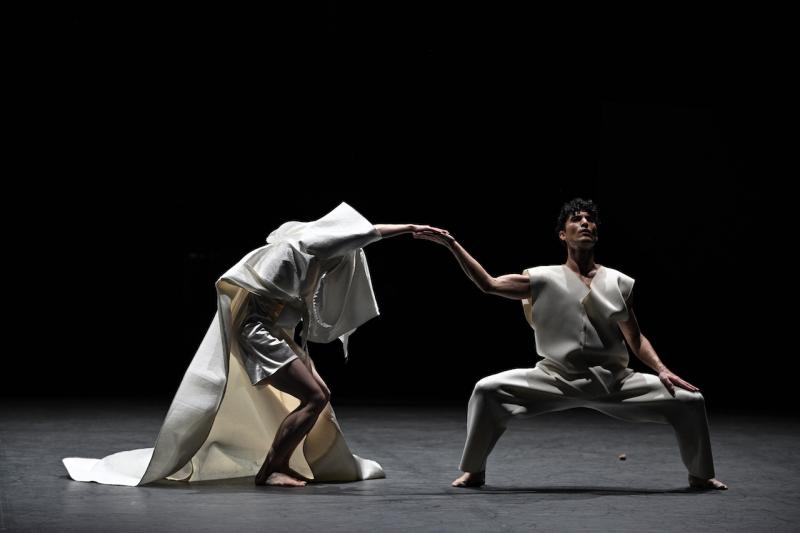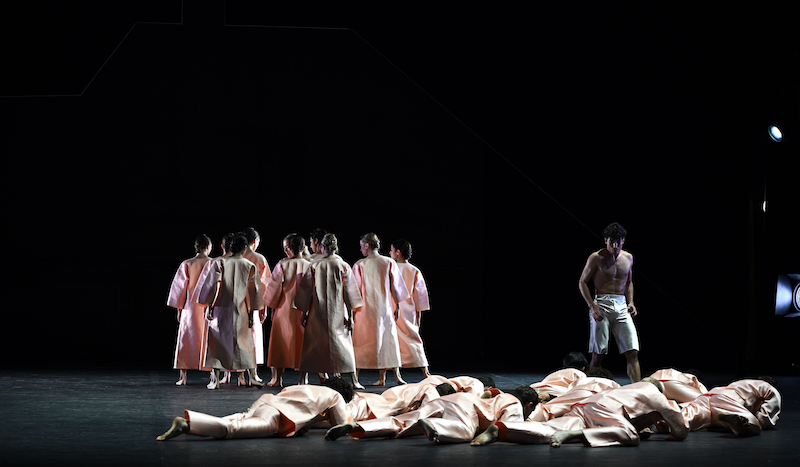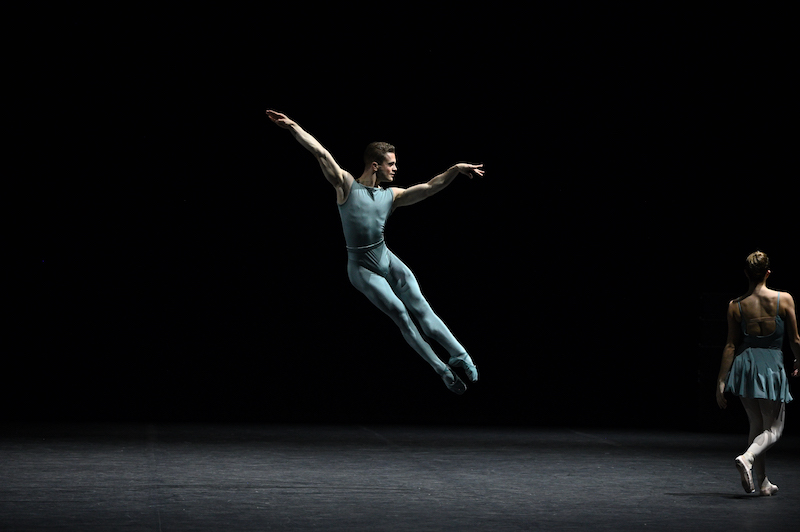English National Ballet: Ek, Forsythe, Quagebeur review - two masters, two marvels | reviews, news & interviews
English National Ballet: Ek, Forsythe, Quagebeur review - two masters, two marvels
English National Ballet: Ek, Forsythe, Quagebeur review - two masters, two marvels
ENB shows its range in a devastating new Rite of Spring from Mats Ek, and pop heaven from William Forsythe

Of all the classic musical scores that could appeal to a choreographer, three are catnip: Ravel’s Bolero, Bizet’s Carmen, and Stravinsky’s Rite of Spring. Each has been set dozens of times and the veteran Swedish dancemaker Mats Ek has notch
Such is the pull of Rite, in fact, that Ek has just created his second version, almost 40 years after his first. It wasn’t that he was unhappy with that earlier Rite, he told an interviewer, but he felt that the drama of the music had more to uncover – specifically on the subject of “young women being forced into a tradition, which has become such a major topic today”.
Cue the 25-minute work that English National Ballet has just premiered at Sadler’s Wells, which could just as easily have borne the title #forcedmarriage. It’s fitting that this new work should be the final commission of ENB’s director Tamara Rojo before she departs to take the helm of San Francisco Ballet. Under her watch gender politics have found a surprisingly comfortable place in ballet.
 The distinctive dance vocabulary of Mats Ek, on the other hand, is deliberately discomfitting, distorting the usual lines of classical dance with deep squats, flexed feet and flat brandished hands – less jazz hands than having-a-nervous-breakdown hands. Ek's work is fierce and strange, and it’s not outlandish to find parallels between this latest response to Stravinsky's score and the Nijinsky original – the one that famously caused a punchup in the stalls at its premiere in 1913. There were no violent disturbances to my knowledge at Sadler’s Wells, but there were muffled sniggers.
The distinctive dance vocabulary of Mats Ek, on the other hand, is deliberately discomfitting, distorting the usual lines of classical dance with deep squats, flexed feet and flat brandished hands – less jazz hands than having-a-nervous-breakdown hands. Ek's work is fierce and strange, and it’s not outlandish to find parallels between this latest response to Stravinsky's score and the Nijinsky original – the one that famously caused a punchup in the stalls at its premiere in 1913. There were no violent disturbances to my knowledge at Sadler’s Wells, but there were muffled sniggers.
As in the Nijinsky/Diaghilev production, design decisions impact the way the dancers deliver the steps. While costumes for dance are usually conceived with a view to revealing the body, either by clinging or flowing, Marie-Louise Ekman’s outsize kimono shapes in stiffened silk seem to be doing the opposite, challenging the dancers (some of whom are miniaturised by their giant flapping clothes) to rely on the volcanic thrust of Ek’s choreography to communicate. In part it's this struggle that makes this Rite so dramatically riveting.
For all his avant-garde credentials, Ek believes in having a story. Here, a daughter is subjected to an arranged marriage and trussed up like a parcel for delivery to her future husband. It turns out the boy isn't so bad after all, and together they face down the parents, and the wider community that sets such store by life-sapping rules and rituals. In a triumphant twist on the original dénouement, it's the young woman who has the final say. No virgin sacrifice for her.
The marvel of Ek's image-making is that, for all its seeming abstraction, it throws out very specific resonances. Here are myriad reminders of the many traditional means by which women's agency has been denied – veiling the face, shrouding the body, foot-binding, an expectation of service and humility. Huge lunging leaps from the men speak of martial power, and the father wields a stave – a phallus threatening punishment. Yet there is tenderness too for the young couple: what turns into a romping love duet begins as a tentative probing of the empty spaces around the other's body.
Best of all, though, is Ek's spot-on response to the music and its mix of precision and eruption, control and savagery. What we see matches what Stravinsky makes us feel, and for this the ENB Philharmonic under Gavin Sutherland must take some of the credit. Here’s hoping that this ballet company will be brave enough to keep programming this strong, stark Rite.
 Here, it's balanced by the fun and fizz of Blake Works I, the work of another great septaguarian, William Forsythe. This was once a choreographer who scared the living daylights out of us, weaponising the pointe shoe and tugging at ballet's warp and weft until his dancers looked little short of disabled. Now, at 72, he’s done a reverse ferret. His latest thing is to set ultra-formal ballet steps to disco music. The result, far from difficult or odd, is pure, joyous entertainment, and audiences can’t get enough of it.
Here, it's balanced by the fun and fizz of Blake Works I, the work of another great septaguarian, William Forsythe. This was once a choreographer who scared the living daylights out of us, weaponising the pointe shoe and tugging at ballet's warp and weft until his dancers looked little short of disabled. Now, at 72, he’s done a reverse ferret. His latest thing is to set ultra-formal ballet steps to disco music. The result, far from difficult or odd, is pure, joyous entertainment, and audiences can’t get enough of it.
Blake Works I is a sequence of dances set to a selection of songs by James Blake. Is the choreographer deliberately channelling Balanchine’s Serenade in the opening moments, I wonder, as a stageful of chignoned women in pale blue tunics tilt their hips as one on a musical cue? I wouldn’t put it past him. But the cascade of classical joy that follows asks for no prior knowledge, just open eyes and ears and a set of toes to tap. ENB first presented this gorgeous confection in its Forsythe Evening earlier this year and I can't say I'd mind if it featured in every triple bill for the next 10 – it's that good. The dancers clearly love it too, and its raises their game. In such purely classical steps (pictured above) there can be no fudging, no approximation, and ENB really nails it.
The casualty of the evening was Stina Quagebeur, whose Take Five Blues – perfectly pleasant and well put-together – had the misfortune of being sandwiched between the work of titans.
- Ek, Forsythe, Quagebeur continues today at Sadler's Wells, at 2.30pm and 7.30pm
- More dance reviews on theartsdesk
rating
Share this article
The future of Arts Journalism
You can stop theartsdesk.com closing!
We urgently need financing to survive. Our fundraising drive has thus far raised £49,000 but we need to reach £100,000 or we will be forced to close. Please contribute here: https://gofund.me/c3f6033d
And if you can forward this information to anyone who might assist, we’d be grateful.

Subscribe to theartsdesk.com
Thank you for continuing to read our work on theartsdesk.com. For unlimited access to every article in its entirety, including our archive of more than 15,000 pieces, we're asking for £5 per month or £40 per year. We feel it's a very good deal, and hope you do too.
To take a subscription now simply click here.
And if you're looking for that extra gift for a friend or family member, why not treat them to a theartsdesk.com gift subscription?
more Dance
 'We are bowled over!' Thank you for your messages of love and support
Much-appreciated words of commendation from readers and the cultural community
'We are bowled over!' Thank you for your messages of love and support
Much-appreciated words of commendation from readers and the cultural community
 Like Water for Chocolate, Royal Ballet review - splendid dancing and sets, but there's too much plot
Christopher Wheeldon's version looks great but is too muddling to connect with fully
Like Water for Chocolate, Royal Ballet review - splendid dancing and sets, but there's too much plot
Christopher Wheeldon's version looks great but is too muddling to connect with fully
 iD-Reloaded, Cirque Éloize, Marlowe Theatre, Canterbury review - attitude, energy and invention
A riotous blend of urban dance music, hip hop and contemporary circus
iD-Reloaded, Cirque Éloize, Marlowe Theatre, Canterbury review - attitude, energy and invention
A riotous blend of urban dance music, hip hop and contemporary circus
 How to be a Dancer in 72,000 Easy Lessons, Teaċ Daṁsa review - a riveting account of a life in dance
Michael Keegan-Dolan's unique hybrid of physical theatre and comic monologue
How to be a Dancer in 72,000 Easy Lessons, Teaċ Daṁsa review - a riveting account of a life in dance
Michael Keegan-Dolan's unique hybrid of physical theatre and comic monologue
 A Single Man, Linbury Theatre review - an anatomy of melancholy, with breaks in the clouds
Ed Watson and Jonathan Goddard are extraordinary in Jonathan Watkins' dance theatre adaptation of Isherwood's novel
A Single Man, Linbury Theatre review - an anatomy of melancholy, with breaks in the clouds
Ed Watson and Jonathan Goddard are extraordinary in Jonathan Watkins' dance theatre adaptation of Isherwood's novel
 Peaky Blinders: The Redemption of Thomas Shelby, Rambert, Sadler's Wells review - exciting dancing, if you can see it
Six TV series reduced to 100 minutes' dance time doesn't quite compute
Peaky Blinders: The Redemption of Thomas Shelby, Rambert, Sadler's Wells review - exciting dancing, if you can see it
Six TV series reduced to 100 minutes' dance time doesn't quite compute
 Giselle, National Ballet of Japan review - return of a classic, refreshed and impeccably danced
First visit by Miyako Yoshida's company leaves you wanting more
Giselle, National Ballet of Japan review - return of a classic, refreshed and impeccably danced
First visit by Miyako Yoshida's company leaves you wanting more
 Quadrophenia, Sadler's Wells review - missed opportunity to give new stage life to a Who classic
The brilliant cast need a tighter score and a stronger narrative
Quadrophenia, Sadler's Wells review - missed opportunity to give new stage life to a Who classic
The brilliant cast need a tighter score and a stronger narrative
 The Midnight Bell, Sadler's Wells review - a first reprise for one of Matthew Bourne's most compelling shows to date
The after-hours lives of the sad and lonely are drawn with compassion, originality and skill
The Midnight Bell, Sadler's Wells review - a first reprise for one of Matthew Bourne's most compelling shows to date
The after-hours lives of the sad and lonely are drawn with compassion, originality and skill
 Ballet to Broadway: Wheeldon Works, Royal Ballet review - the impressive range and reach of Christopher Wheeldon's craft
The title says it: as dancemaker, as creative magnet, the man clearly works his socks off
Ballet to Broadway: Wheeldon Works, Royal Ballet review - the impressive range and reach of Christopher Wheeldon's craft
The title says it: as dancemaker, as creative magnet, the man clearly works his socks off
 The Forsythe Programme, English National Ballet review - brains, beauty and bravura
Once again the veteran choreographer and maverick William Forsythe raises ENB's game
The Forsythe Programme, English National Ballet review - brains, beauty and bravura
Once again the veteran choreographer and maverick William Forsythe raises ENB's game
 Sad Book, Hackney Empire review - What we feel, what we show, and the many ways we deal with sadness
A book about navigating grief feeds into unusual and compelling dance theatre
Sad Book, Hackney Empire review - What we feel, what we show, and the many ways we deal with sadness
A book about navigating grief feeds into unusual and compelling dance theatre

Add comment